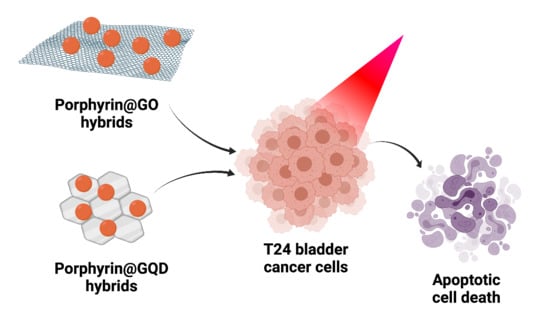Graphene Oxide and Graphene Quantum Dots as Delivery Systems of Cationic Porphyrins: Photo-Antiproliferative Activity Evaluation towards T24 Human Bladder Cancer Cells
Abstract
:1. Introduction
2. Materials and Methods
2.1. Syntheses of Tetracationic Porphyrins
2.1.1. Synthesis of TMPyP
2.1.2. Synthesis of Zn-TMPyP
2.1.3. Synthesis of P1-C5
2.2. Characterization of Porphyrin@GO and Porphyrin@GQDs Hybrids
2.3. Light Exposure
2.4. Cell Cultures and Cell Treatment
2.5. ROS and Singlet Oxygen Generation
2.6. Cell Viability and Mechanisms of Cellular Death
2.7. Intracellular Localization
3. Results and Discussion
3.1. Synthesis and Characterization of the Tetracationic Porphyrins
3.2. Characterization of Neat Carbon Nanomaterials
3.3. Synthesis and Characterization of Non-Covalent Hybrids of Porphyrin@Carbon Nanomaterials
3.3.1. Porphyrin@GO Hybrids
3.3.2. Porphyrin@GQDs Hybrids
3.4. Biological Experiments
3.4.1. Photo-Antiproliferative Activity of non-Immobilized Porphyrins on T24 Human Bladder Cancer Cells
3.4.2. Detection of Singlet Oxygen and Other ROS in Cell Cultures
3.4.3. Flow Cytometric Analysis
3.4.4. Photo-Antiproliferative Activity of Porphyrin@Carbon Nanomaterials on T24 Cells
Preparation of Porphyrin@GO and Porphyrin@GQD Hybrids for Cellular Experiments
3.4.5. Photo-Antiproliferative Activity of Porphyrin@GO Hybrids
3.4.6. Photo-Antiproliferative Activity of Porphyrin@GQDs Hybrids
3.4.7. Intracellular Localization
4. Conclusions
Supplementary Materials
Author Contributions
Funding
Institutional Review Board Statement
Informed Consent Statement
Data Availability Statement
Acknowledgments
Conflicts of Interest
References
- Sung, H.; Ferlay, J.; Siegel, R.L.; Laversanne, M.; Soerjomataram, I.; Jemal, A.; Bray, F. Global Cancer Statistics 2020: GLOBOCAN Estimates of Incidence and Mortality Worldwide for 36 Cancers in 185 Countries. CA A Cancer J. Clin. 2021, 71, 209–249. [Google Scholar] [CrossRef] [PubMed]
- Lamm, D.L.; Morales, A. A BCG Success Story: From Prevention of Tuberculosis to Optimal Bladder Cancer Treatment. Vaccine 2021, S0264-410X(21)01046-X. [Google Scholar] [CrossRef] [PubMed]
- Cambier, S.; Sylvester, R.J.; Collette, L.; Gontero, P.; Brausi, M.A.; van Andel, G.; Kirkels, W.J.; Silva, F.C.D.; Oosterlinck, W.; Prescott, S.; et al. EORTC Nomograms and Risk Groups for Predicting Recurrence, Progression, and Disease-Specific and Overall Survival in Non–Muscle-Invasive Stage Ta–T1 Urothelial Bladder Cancer Patients Treated with 1–3 Years of Maintenance Bacillus Calmette-Guérin. Eur. Urol. 2016, 69, 60–69. [Google Scholar] [CrossRef] [PubMed]
- Zimmermann, K.; Mostafaei, H.; Heidenreich, A.; Schmelz, H.U.; Shariat, S.F.; Mori, K. Health-Related Quality of Life in Bladder Cancer Patients: General and Cancer-Specific Instruments. Part 1. Curr. Opin. Urol. 2021, 31, 297–303. [Google Scholar] [CrossRef]
- Inoue, K. 5-Aminolevulinic Acid-Mediated Photodynamic Therapy for Bladder Cancer. Int. J. Urol. 2017, 24, 97–101. [Google Scholar] [CrossRef] [Green Version]
- Tabish, T.A.; Scotton, C.J.; Ferguson, D.C.J.; Lin, L.; van der Veen, A.; Lowry, S.; Ali, M.; Jabeen, F.; Ali, M.; Winyard, P.G.; et al. Biocompatibility and Toxicity of Graphene Quantum Dots for Potential Application in Photodynamic Therapy. Nanomedicine 2018, 13, 1923–1937. [Google Scholar] [CrossRef] [Green Version]
- Tabish, T.A.; Zhang, S.; Winyard, P.G. Developing the next Generation of Graphene-Based Platforms for Cancer Therapeutics: The Potential Role of Reactive Oxygen Species. Redox Biol. 2018, 15, 34–40. [Google Scholar] [CrossRef]
- Tabish, T.; Pranjol, M.; Horsell, D.; Rahat, A.; Whatmore, J.; Winyard, P.; Zhang, S. Graphene Oxide-Based Targeting of Extracellular Cathepsin D and Cathepsin L As A Novel Anti-Metastatic Enzyme Cancer Therapy. Cancers 2019, 11, 319. [Google Scholar] [CrossRef] [Green Version]
- Li, X.; Kolemen, S.; Yoon, J.; Akkaya, E.U. Activatable Photosensitizers: Agents for Selective Photodynamic Therapy. Adv. Funct. Mater. 2017, 27, 1604053. [Google Scholar] [CrossRef]
- Ethirajan, M.; Chen, Y.; Joshi, P.; Pandey, R.K. The Role of Porphyrin Chemistry in Tumor Imaging and Photodynamic Therapy. Chem. Soc. Rev. 2011, 40, 340–362. [Google Scholar] [CrossRef]
- Hamblin, M.R.; Yingying, H. Imaging in Photodynamic Therapy, 1st ed.; Series in Cellular and Clinical Imaging; CRC Press: Boca Raton, FL, USA, 2017. [Google Scholar]
- Kou, J.; Dou, D.; Yang, L. Porphyrin Photosensitizers in Photodynamic Therapy and Its Applications. Oncotarget 2017, 8, 81591–81603. [Google Scholar] [CrossRef] [PubMed] [Green Version]
- Railkar, R.; Agarwal, P.K. Photodynamic Therapy in the Treatment of Bladder Cancer: Past Challenges and Current Innovations. Eur. Urol. Focus 2018, 4, 509–511. [Google Scholar] [CrossRef]
- Gomes, A.T.P.C.; Neves, M.G.P.M.S.; Cavaleiro, J.A.S. Cancer, Photodynamic Therapy and Porphyrin-Type Derivatives. An. Acad. Bras. Ciênc. 2018, 90, 993–1026. [Google Scholar] [CrossRef]
- Nyman, E.S.; Hynninen, P.H. Research Advances in the Use of Tetrapyrrolic Photosensitizers for Photodynamic Therapy. J. Photochem. Photobiol. B Biol. 2004, 73, 1–28. [Google Scholar] [CrossRef] [PubMed]
- Mesquita, M.Q.; Dias, C.J.; Gamelas, S.; Fardilha, M.; Neves, M.G.P.M.S.; Faustino, M.A.F. An Insight on the Role of Photosensitizer Nanocarriers for Photodynamic Therapy. An. Acad. Bras. Ciênc. 2018, 90, 1101–1130. [Google Scholar] [CrossRef] [PubMed] [Green Version]
- Calixto, G.; Bernegossi, J.; de Freitas, L.; Fontana, C.; Chorilli, M. Nanotechnology-Based Drug Delivery Systems for Photodynamic Therapy of Cancer: A Review. Molecules 2016, 21, 342. [Google Scholar] [CrossRef]
- Ahirwar, S.; Mallick, S.; Bahadur, D. Photodynamic Therapy Using Graphene Quantum Dot Derivatives. J. Solid State Chem. 2020, 282, 121107. [Google Scholar] [CrossRef]
- Su, S.; Wang, J.; Vargas, E.; Wei, J.; Martínez-Zaguilán, R.; Sennoune, S.R.; Pantoya, M.L.; Wang, S.; Chaudhuri, J.; Qiu, J. Porphyrin Immobilized Nanographene Oxide for Enhanced and Targeted Photothermal Therapy of Brain Cancer. ACS Biomater. Sci. Eng. 2016, 2, 1357–1366. [Google Scholar] [CrossRef]
- Bartoň Tománková, K.; Opletalová, A.; Poláková, K.; Kalytchuk, S.; Jiravová, J.; Malohlava, J.; Malina, L.; Kolářová, H. Size-Selected Graphene Oxide Loaded with Photosensitizer (TMPyP) for Targeting Photodynamic Therapy In Vitro. Processes 2020, 8, 251. [Google Scholar] [CrossRef] [Green Version]
- Gazzi, A.; Fusco, L.; Khan, A.; Bedognetti, D.; Zavan, B.; Vitale, F.; Yilmazer, A.; Delogu, L.G. Photodynamic Therapy Based on Graphene and MXene in Cancer Theranostics. Front. Bioeng. Biotechnol. 2019, 7, 295. [Google Scholar] [CrossRef] [PubMed] [Green Version]
- Managa, M.; Ngoy, B.P.; Nyokong, T. Photophysical Properties and Photodynamic Therapy Activity of a Meso -Tetra(4-Carboxyphenyl)Porphyrin Tetramethyl Ester–Graphene Quantum Dot Conjugate. New J. Chem. 2019, 43, 4518–4524. [Google Scholar] [CrossRef]
- Cao, Y.; Dong, H.; Yang, Z.; Zhong, X.; Chen, Y.; Dai, W.; Zhang, X. Aptamer-Conjugated Graphene Quantum Dots/Porphyrin Derivative Theranostic Agent for Intracellular Cancer-Related MicroRNA Detection and Fluorescence-Guided Photothermal/Photodynamic Synergetic Therapy. ACS Appl. Mater. Interfaces 2017, 9, 159–166. [Google Scholar] [CrossRef]
- Zhang, L.; Xia, J.; Zhao, Q.; Liu, L.; Zhang, Z. Functional Graphene Oxide as a Nanocarrier for Controlled Loading and Targeted Delivery of Mixed Anticancer Drugs. Small 2010, 6, 537–544. [Google Scholar] [CrossRef] [PubMed]
- Liu, J.; Huang, Y.; Kumar, A.; Tan, A.; Jin, S.; Mozhi, A.; Liang, X.-J. PH-Sensitive Nano-Systems for Drug Delivery in Cancer Therapy. Biotechnol. Adv. 2014, 32, 693–710. [Google Scholar] [CrossRef]
- Kavitha, T.; Haider Abdi, S.I.; Park, S.-Y. PH-Sensitive Nanocargo Based on Smart Polymer Functionalized Graphene Oxide for Site-Specific Drug Delivery. Phys. Chem. Chem. Phys. 2013, 15, 5176. [Google Scholar] [CrossRef]
- Armarego, W.L.F.; Perrin, D.D. Purification of Laboratory Chemicals, 4th ed.; Butterworth-Heinemann: Oxford, UK, 1996. [Google Scholar]
- Adler, A.D. Porphyrins as Model Systems for Studying Structural Relationships. Ann. N. Y. Acad. Sci. 1973, 206, 7–17. [Google Scholar] [CrossRef] [PubMed]
- Gonsalves, A.M.A.R.; Varejão, J.M.T.B.; Pereira, M.M. Some New Aspects Related to the Synthesis Ofmeso-Substituted Porphyrins. J. Heterocycl. Chem. 1991, 98, 635–640. [Google Scholar] [CrossRef]
- Moreira, X.; Santos, P.; Faustino, M.A.F.; Raposo, M.M.M.; Costa, S.P.G.; Moura, N.M.M.; Gomes, A.T.P.C.; Almeida, A.; Neves, M.G.P.M.S. An Insight into the Synthesis of Cationic Porphyrin-Imidazole Derivatives and Their Photodynamic Inactivation Efficiency against Escherichia Coli. Dye. Pigment. 2020, 178, 108330. [Google Scholar] [CrossRef]
- Jiang, L.; Zaenglein, R.A.; Engle, J.T.; Mittal, C.; Hartley, C.S.; Ziegler, C.J.; Wang, H. Water-Soluble Ionic Benzoporphyrins. Chem. Commun. 2012, 48, 6927. [Google Scholar] [CrossRef] [PubMed]
- Deshpande, R.; Jiang, L.; Schmidt, G.; Rakovan, J.; Wang, X.; Wheeler, K.; Wang, H. A Concise Approach to the Synthesis of Opp -Dibenzoporphyrins through the Heck Reaction. Org. Lett. 2009, 11, 4251–4253. [Google Scholar] [CrossRef] [PubMed]
- Kumar, P.K.; Bhyrappa, P.; Varghese, B. An Improved Protocol for the Synthesis of Antipodal β-Tetrabromo-Tetraphenylporphyrin and the Crystal Structure of Its Zn(II) Complex. Tetrahedron Lett. 2003, 44, 4849–4851. [Google Scholar] [CrossRef]
- Gollmer, A.; Arnbjerg, J.; Blaikie, F.H.; Pedersen, B.W.; Breitenbach, T.; Daasbjerg, K.; Glasius, M.; Ogilby, P.R. Singlet Oxygen Sensor Green®: Photochemical Behavior in Solution and in a Mammalian Cell: Photochemistry and Photobiology. Photochem. Photobiol. 2011, 87, 671–679. [Google Scholar] [CrossRef]
- Gonsalves, A.D.A.R.; Pereira, M.M. A New Look into the Rothemund Meso-tetraalkyl and Tetraarylporphyrin Synthesis. J. Heterocycl. Chem. 1985, 22, 931–933. [Google Scholar] [CrossRef]
- Tetsuka, H.; Asahi, R.; Nagoya, A.; Okamoto, K.; Tajima, I.; Ohta, R.; Okamoto, A. Optically Tunable Amino-Functionalized Graphene Quantum Dots. Adv. Mater. 2012, 24, 5333–5338. [Google Scholar] [CrossRef]
- Geng, B.; Fang, F.; Li, P.; Xu, S.; Pan, D.; Zhang, Y.; Shen, L. Surface Charge-Dependent Osteogenic Behaviors of Edge-Functionalized Graphene Quantum Dots. Chem. Eng. J. 2020, 417, 128125. [Google Scholar] [CrossRef]
- Jin, S.H.; Kim, D.H.; Jun, G.H.; Hong, S.H.; Jeon, S. Tuning the Photoluminescence of Graphene Quantum Dots through the Charge Transfer Effect of Functional Groups. ACS Nano 2013, 7, 1239–1245. [Google Scholar] [CrossRef]
- Dervishi, E.; Ji, Z.; Htoon, H.; Sykora, M.; Doorn, S.K. Raman Spectroscopy of Bottom-up Synthesized Graphene Quantum Dots: Size and Structure Dependence. Nanoscale 2019, 11, 16571–16581. [Google Scholar] [CrossRef] [PubMed]
- Ferrari, A.C.; Basko, D.M. Raman Spectroscopy as a Versatile Tool for Studying the Properties of Graphene. Nat. Nanotechnol. 2013, 8, 235–246. [Google Scholar] [CrossRef] [PubMed] [Green Version]
- Lopes, J.; Estrada, A.; Fateixa, S.; Ferro, M.; Trindade, T. A General Route for Growing Metal Sulfides onto Graphene Oxide and Exfoliated Graphite Oxide. Nanomaterials 2017, 7, 245. [Google Scholar] [CrossRef] [PubMed] [Green Version]
- Lai, Q.; Zhu, S.; Luo, X.; Zou, M.; Huang, S. Ultraviolet-Visible Spectroscopy of Graphene Oxides. AIP Adv. 2012, 2, 032146. [Google Scholar] [CrossRef]
- Tsirka, K.; Katsiki, A.; Chalmpes, N.; Gournis, D.; Paipetis, A.S. Mapping of Graphene Oxide and Single Layer Graphene Flakes—Defects Annealing and Healing. Front. Mater. 2018, 5, 37. [Google Scholar] [CrossRef] [Green Version]
- Kim, J.K.; Kim, S.J.; Park, M.J.; Bae, S.; Cho, S.-P.; Du, Q.G.; Wang, D.H.; Park, J.H.; Hong, B.H. Surface-Engineered Graphene Quantum Dots Incorporated into Polymer Layers for High Performance Organic Photovoltaics. Sci. Rep. 2015, 5, 14276. [Google Scholar] [CrossRef]
- Monteiro, A.R.; Ramos, C.I.V.; Fateixa, S.; Moura, N.M.M.; Neves, M.G.P.M.S.; Trindade, T. Hybrids Based on Graphene Oxide and Porphyrin as Tools for Detection and Stabilization of DNA G-Quadruplexes. ACS Omega 2018, 3, 11184–11191. [Google Scholar] [CrossRef] [PubMed]
- Xu, Y.; Zhao, L.; Bai, H.; Hong, W.; Li, C.; Shi, G. Chemically Converted Graphene Induced Molecular Flattening of 5,10,15,20-Tetrakis(1-Methyl-4-Pyridinio)Porphyrin and Its Application for Optical Detection of Cadmium(II) Ions. J. Am. Chem. Soc. 2009, 131, 13490–13497. [Google Scholar] [CrossRef] [PubMed]
- Mao, B.; Calatayud, D.G.; Mirabello, V.; Hodges, B.J.; Martins, J.A.R.; Botchway, S.W.; Mitchels, J.M.; Pascu, S.I. Interactions between an Aryl Thioacetate-Functionalized Zn(II) Porphyrin and Graphene Oxide. Adv. Funct. Mater. 2016, 26, 687–697. [Google Scholar] [CrossRef] [Green Version]
- Cheon, Y.A.; Bae, J.H.; Chung, B.G. Reduced Graphene Oxide Nanosheet for Chemo-Photothermal Therapy. Langmuir 2016, 32, 2731–2736. [Google Scholar] [CrossRef]

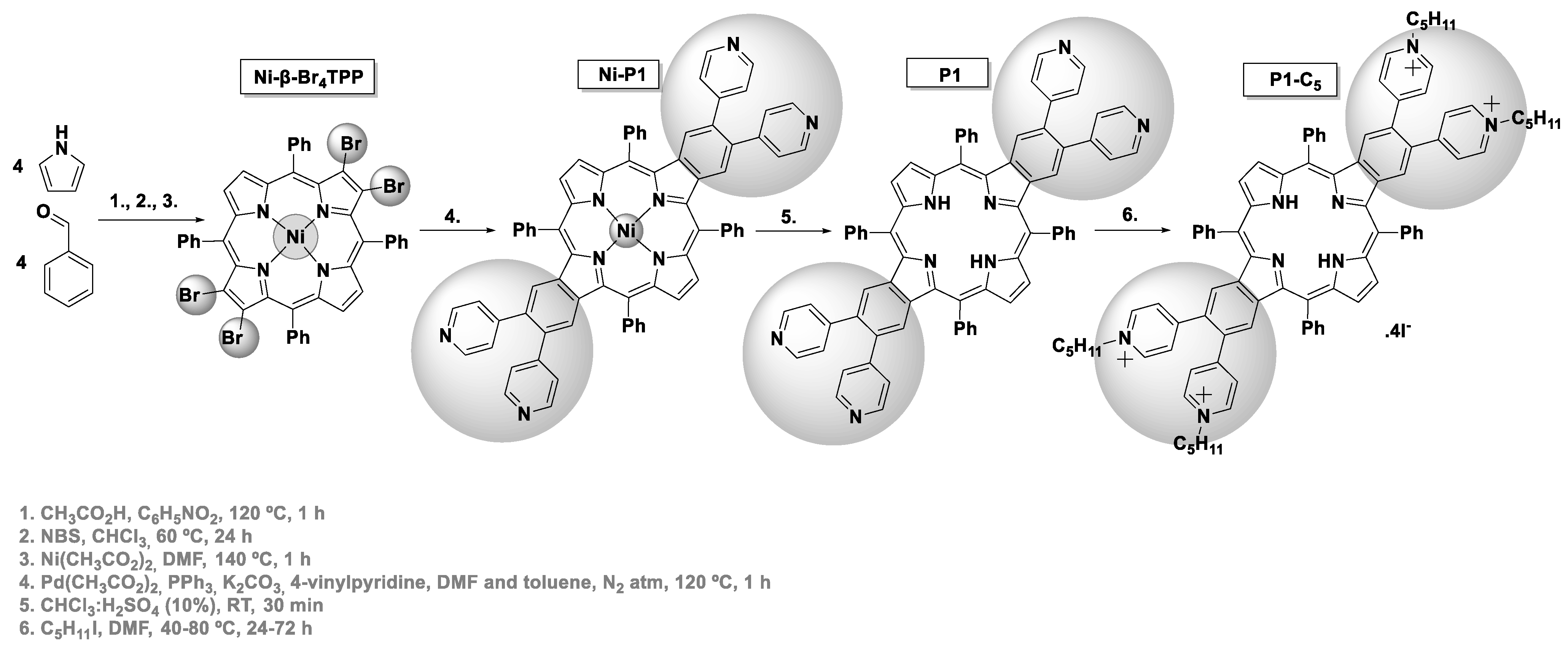
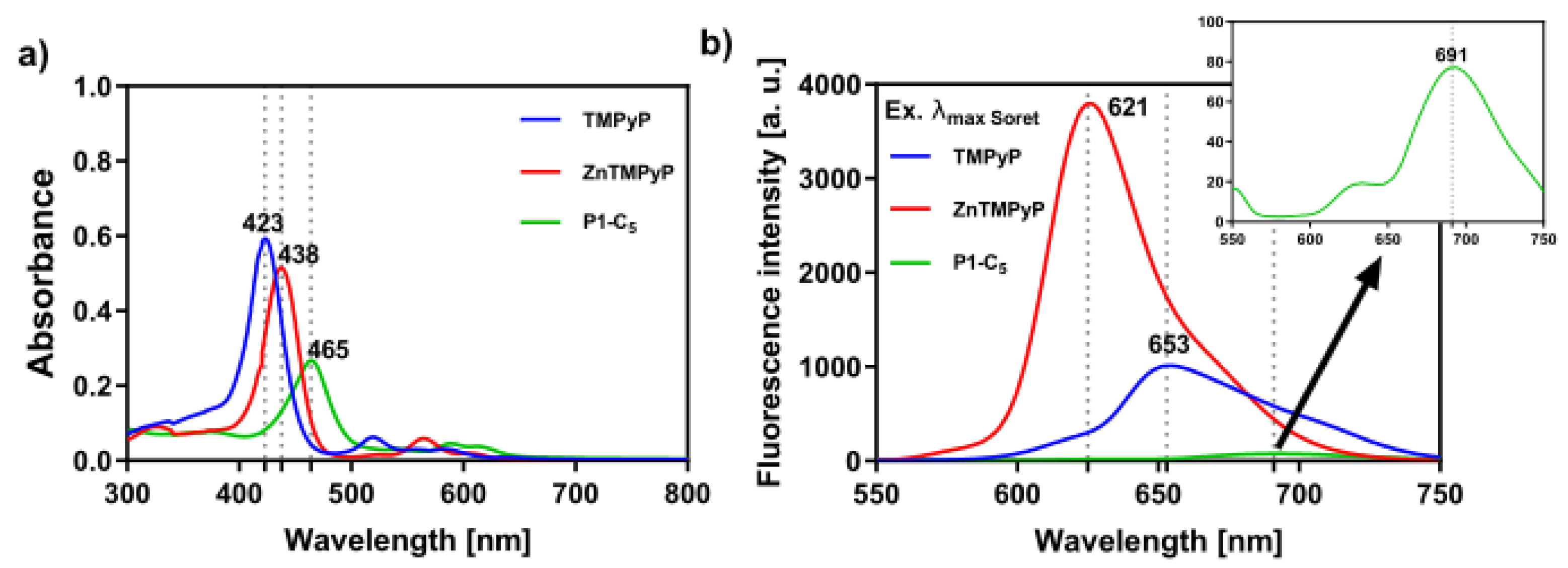

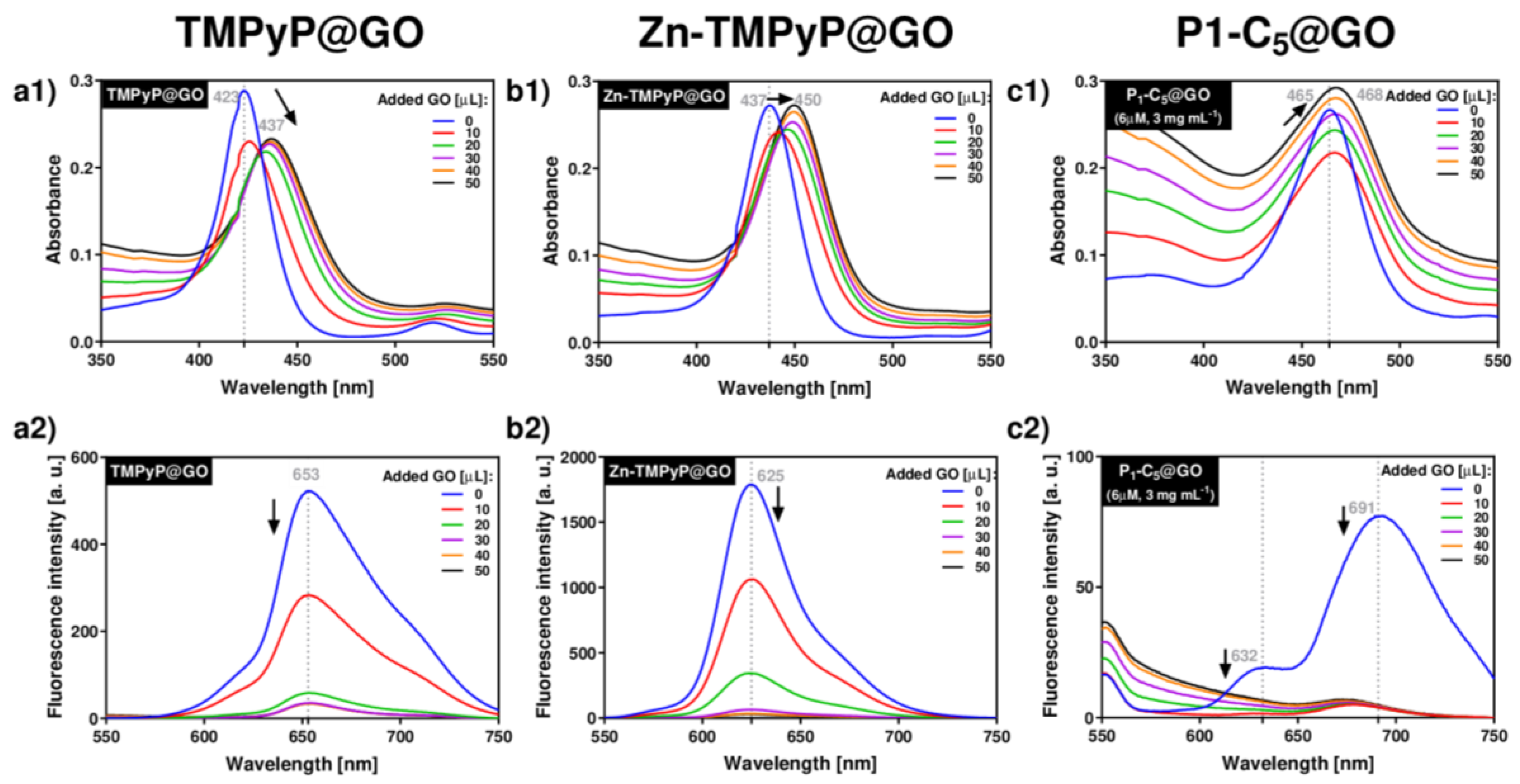
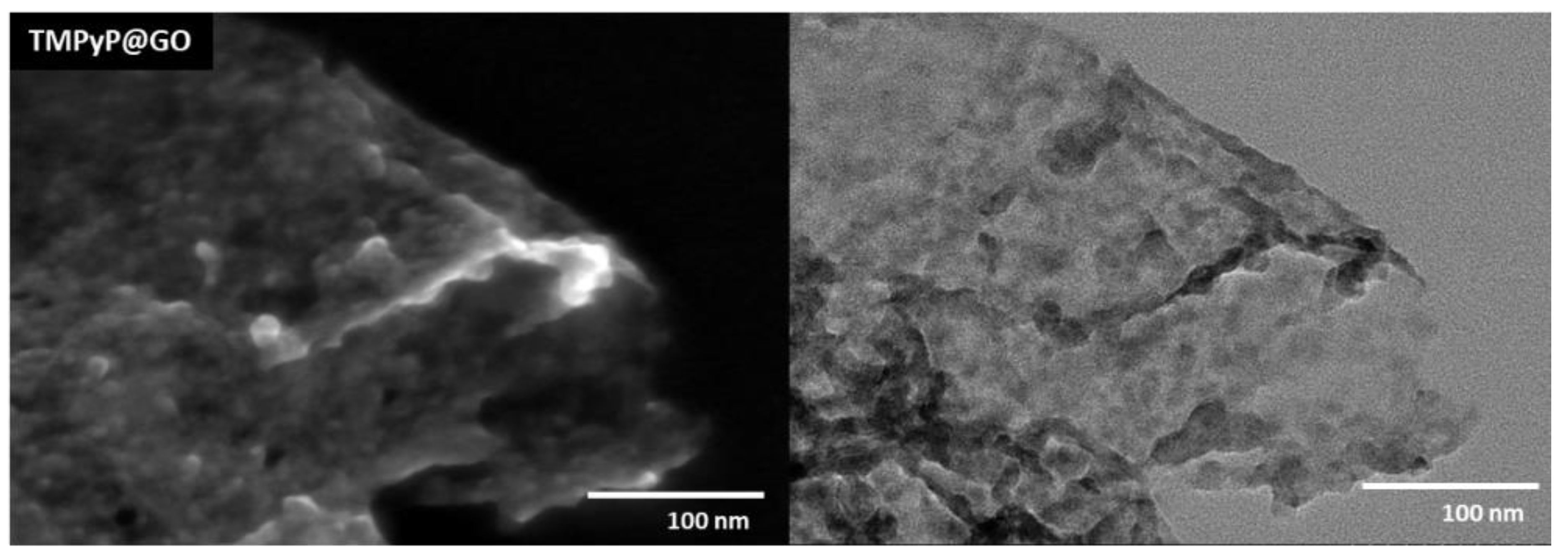
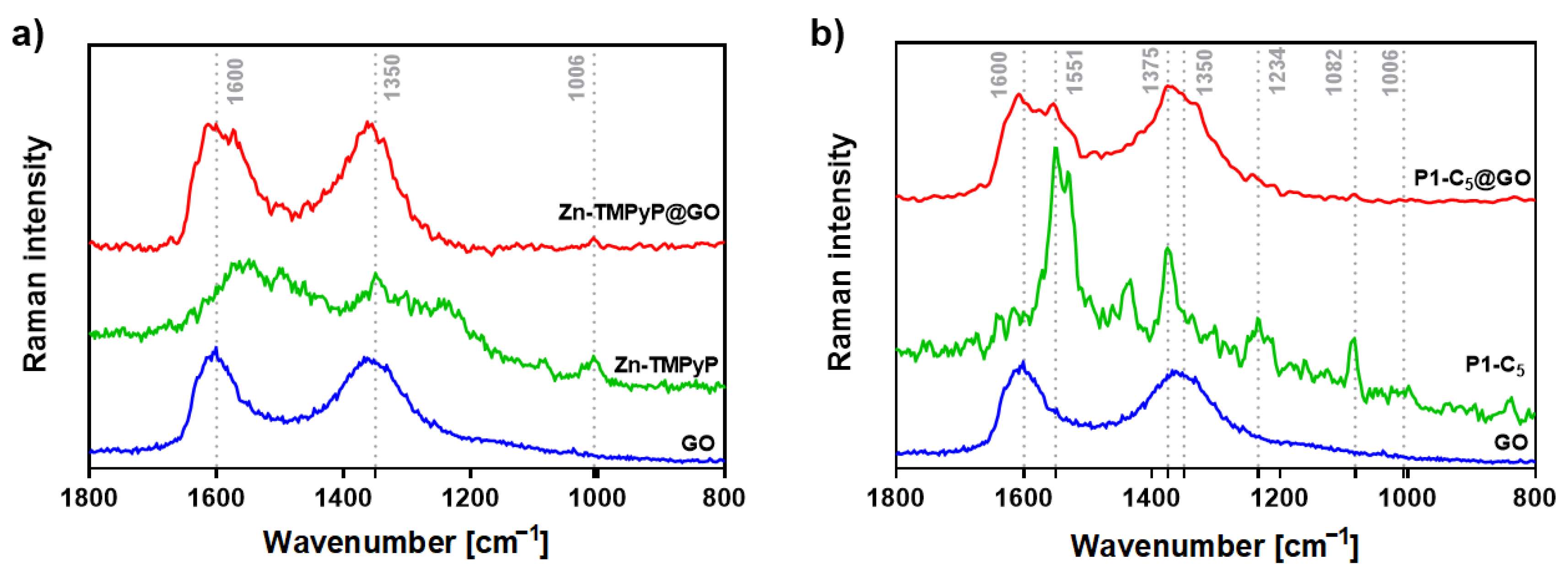
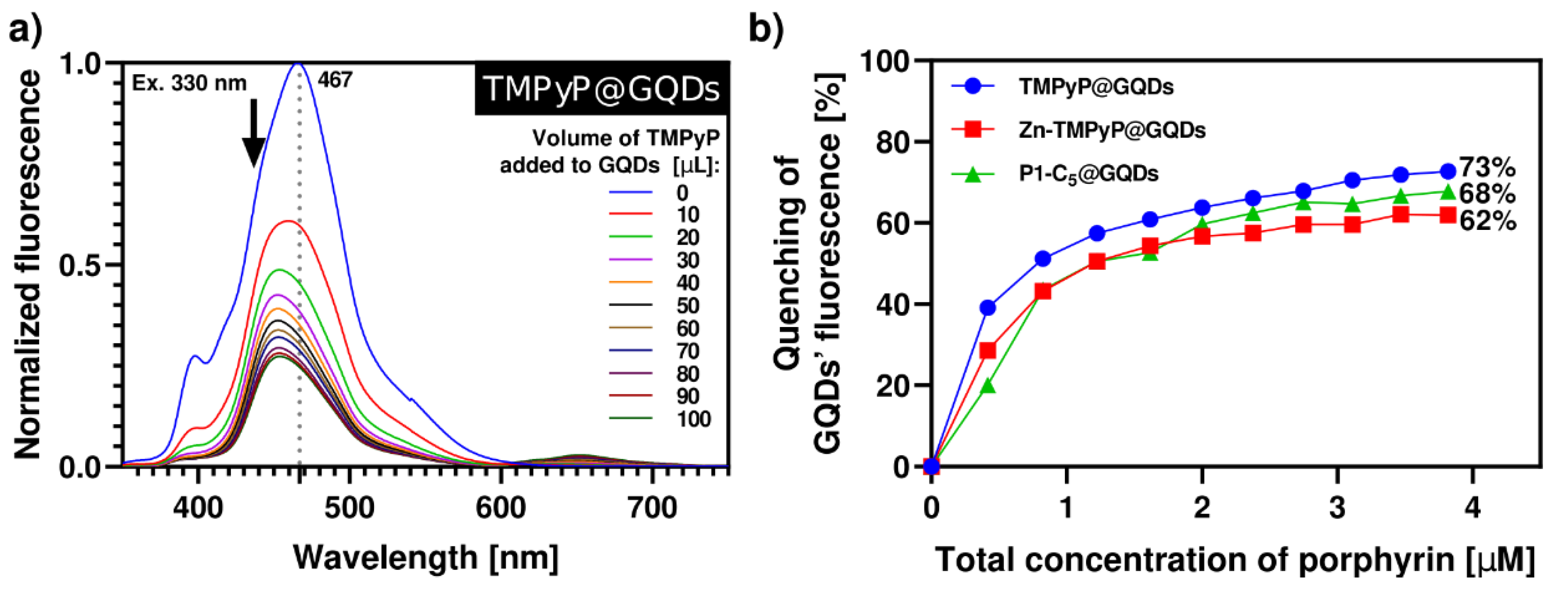
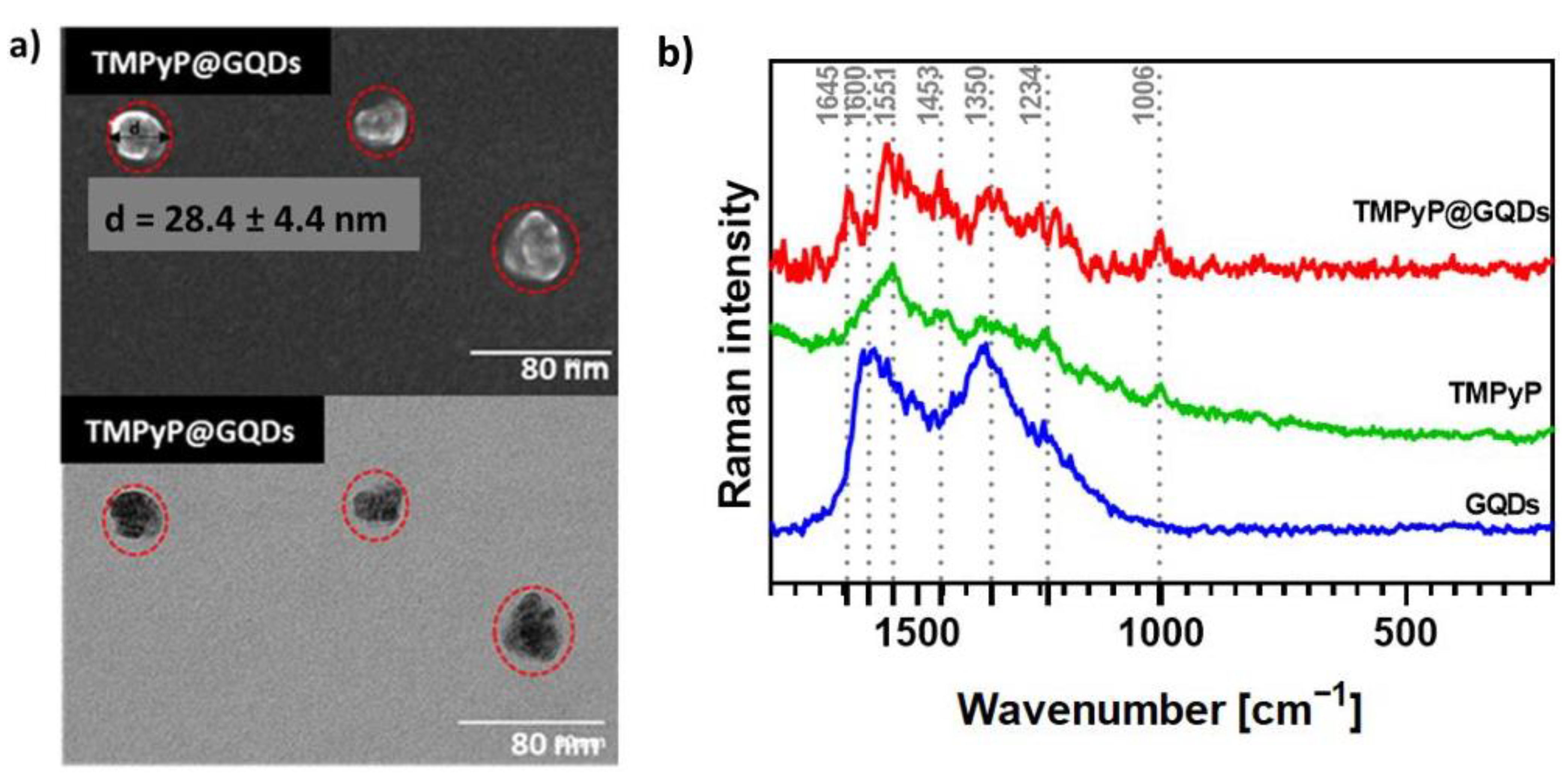
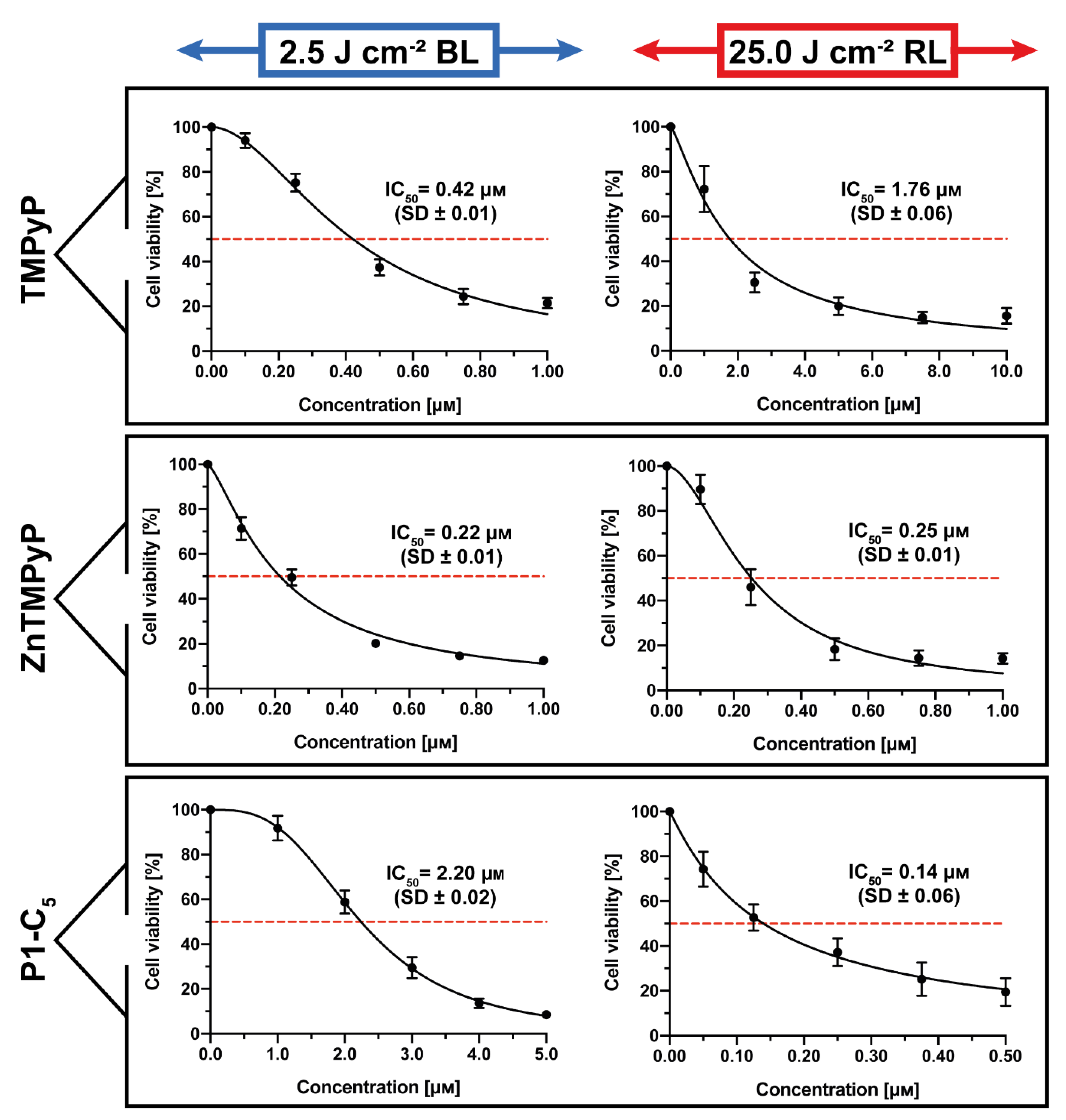

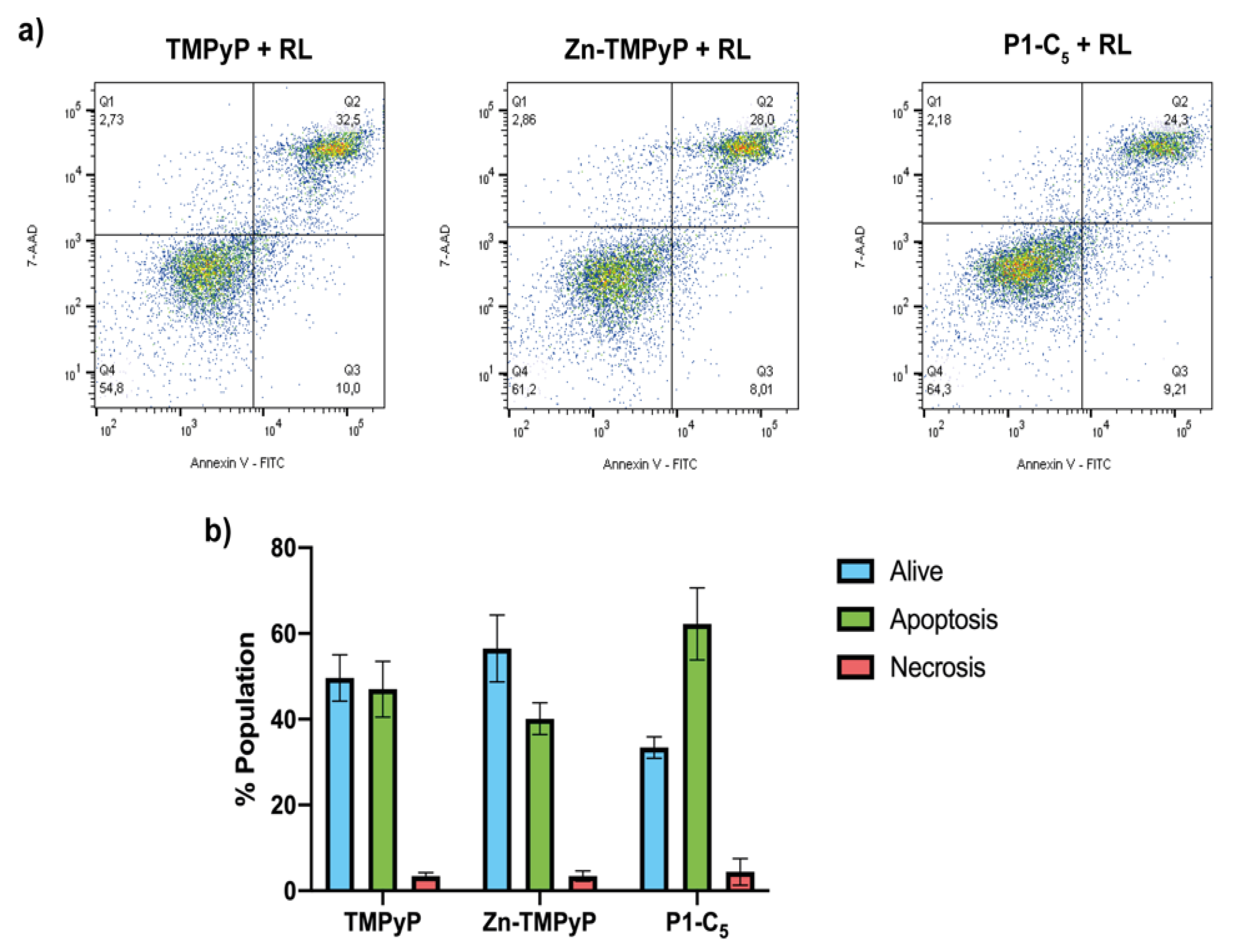
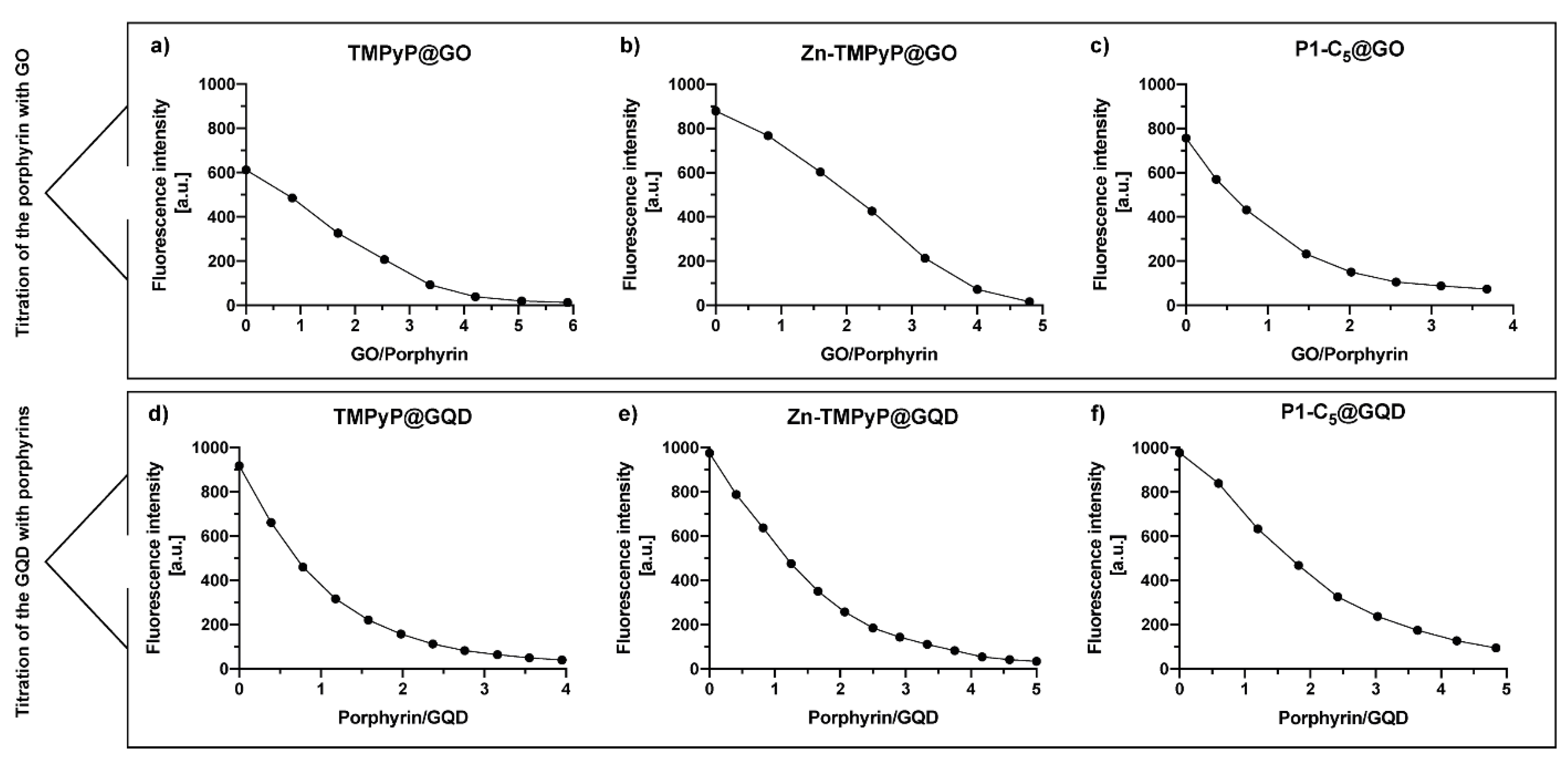


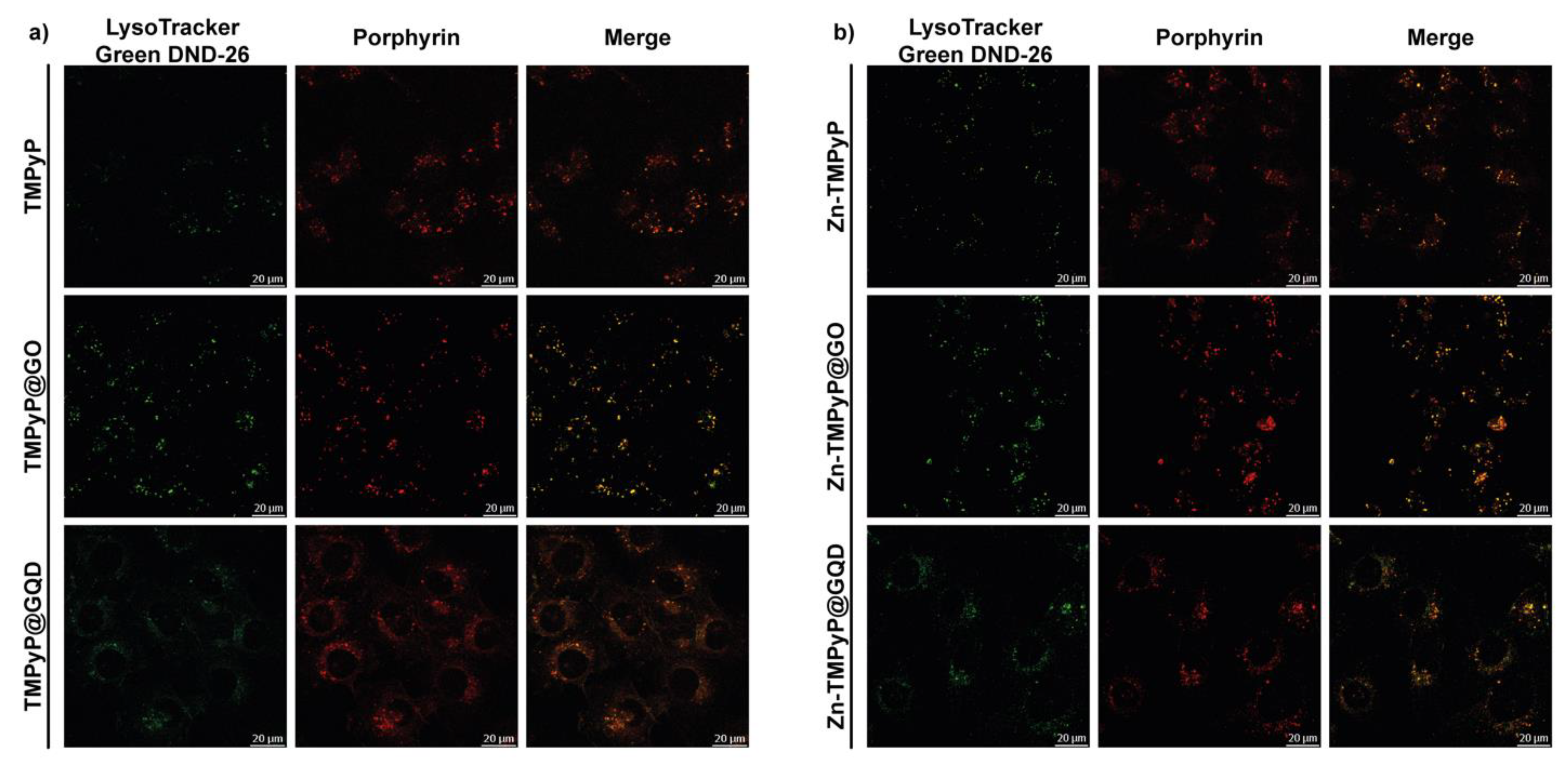
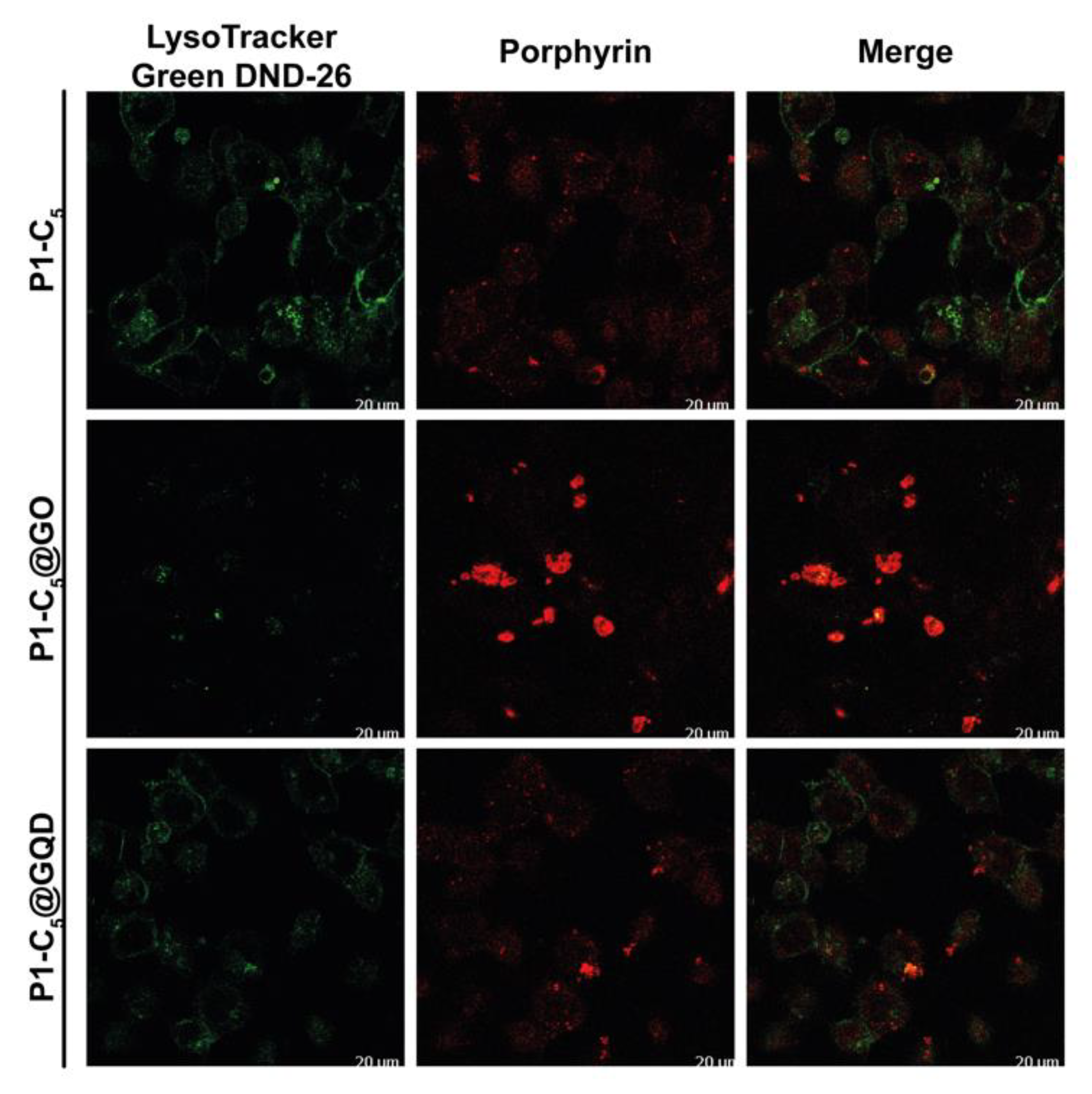
| Porphyrin Derivatives | λ Soret band (nm) | ε (mol−1·dm3·cm−1) | ||
|---|---|---|---|---|
| λ Soret band | λ Blue light (417 nm) | λ Red light (625 nm) | ||
| TMPyP | 423 | 98,823 | 90,688 | 1407 |
| Zn-TMPyP | 438 | 85,792 | 38,860 | 1395 |
| P1-C5 | 465 | 44,468 | 11,955 | 5017 |
| Binding Ratios | Porphyrin@Carbon Nanomaterial | ||
|---|---|---|---|
| TMPyP | Zn-TMPyP | P1-C5 | |
| Binding ratio of Porphyrin/GO | 1/3.8 | 1/4.2 | 1/2 |
| Binding ratio of Porphyrin/GQDs | 2/1 | 3/1 | 2.6/1 |
Publisher’s Note: MDPI stays neutral with regard to jurisdictional claims in published maps and institutional affiliations. |
© 2021 by the authors. Licensee MDPI, Basel, Switzerland. This article is an open access article distributed under the terms and conditions of the Creative Commons Attribution (CC BY) license (https://creativecommons.org/licenses/by/4.0/).
Share and Cite
Menilli, L.; Monteiro, A.R.; Lazzarotto, S.; Morais, F.M.P.; Gomes, A.T.P.C.; Moura, N.M.M.; Fateixa, S.; Faustino, M.A.F.; Neves, M.G.P.M.S.; Trindade, T.; et al. Graphene Oxide and Graphene Quantum Dots as Delivery Systems of Cationic Porphyrins: Photo-Antiproliferative Activity Evaluation towards T24 Human Bladder Cancer Cells. Pharmaceutics 2021, 13, 1512. https://doi.org/10.3390/pharmaceutics13091512
Menilli L, Monteiro AR, Lazzarotto S, Morais FMP, Gomes ATPC, Moura NMM, Fateixa S, Faustino MAF, Neves MGPMS, Trindade T, et al. Graphene Oxide and Graphene Quantum Dots as Delivery Systems of Cationic Porphyrins: Photo-Antiproliferative Activity Evaluation towards T24 Human Bladder Cancer Cells. Pharmaceutics. 2021; 13(9):1512. https://doi.org/10.3390/pharmaceutics13091512
Chicago/Turabian StyleMenilli, Luca, Ana R. Monteiro, Silvia Lazzarotto, Filipe M. P. Morais, Ana T. P. C. Gomes, Nuno M. M. Moura, Sara Fateixa, Maria A. F. Faustino, Maria G. P. M. S. Neves, Tito Trindade, and et al. 2021. "Graphene Oxide and Graphene Quantum Dots as Delivery Systems of Cationic Porphyrins: Photo-Antiproliferative Activity Evaluation towards T24 Human Bladder Cancer Cells" Pharmaceutics 13, no. 9: 1512. https://doi.org/10.3390/pharmaceutics13091512
APA StyleMenilli, L., Monteiro, A. R., Lazzarotto, S., Morais, F. M. P., Gomes, A. T. P. C., Moura, N. M. M., Fateixa, S., Faustino, M. A. F., Neves, M. G. P. M. S., Trindade, T., & Miolo, G. (2021). Graphene Oxide and Graphene Quantum Dots as Delivery Systems of Cationic Porphyrins: Photo-Antiproliferative Activity Evaluation towards T24 Human Bladder Cancer Cells. Pharmaceutics, 13(9), 1512. https://doi.org/10.3390/pharmaceutics13091512












